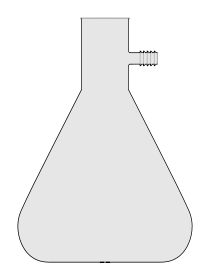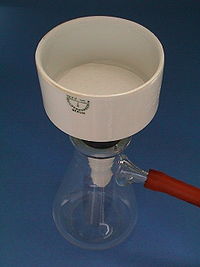
Büchner flask
Encyclopedia


Erlenmeyer flask
An Erlenmeyer flask, also known as a conical flask, is a widely used type of laboratory flask which features a flat bottom, a conical body, and a cylindrical neck. It is named after the German chemist Emil Erlenmeyer, who created it in 1861...
with a short glass tube and hose barb
Hose barb
Hose barbs are cylindrical pieces or parts for attaching and securing of hoses . The barb-like rings on the cylindrical piece allow for an easy push-connection of flexible-plastic or rubber tubing that is not so easily disconnected. Hose barbs are used in machine perfusion and chemistry laboratory...
protruding about an inch from its neck. The short tube and hose barb effectively acts as an adapter over which the end of a thick-walled flexible hose (tubing) can be fitted to form a connection to the flask. The other end of the hose can be connected to source of vacuum
Vacuum
In everyday usage, vacuum is a volume of space that is essentially empty of matter, such that its gaseous pressure is much less than atmospheric pressure. The word comes from the Latin term for "empty". A perfect vacuum would be one with no particles in it at all, which is impossible to achieve in...
such as an aspirator
Aspirator
An aspirator, also called an eductor-jet pump or filter pump, is a device that produces vacuum by means of the Venturi effect. In an aspirator, fluid flows through a tube which then narrows. When the tube narrows, the fluid's speed increases, and because of the Venturi effect, its pressure...
, vacuum pump
Vacuum pump
A vacuum pump is a device that removes gas molecules from a sealed volume in order to leave behind a partial vacuum. The first vacuum pump was invented in 1650 by Otto von Guericke.- Types :Pumps can be broadly categorized according to three techniques:...
, or house vacuum. Preferably this is done through a trap (see below), which is designed to prevent the sucking back of water from the aspirator into the Büchner flask.
The thick wall of the Büchner flask provides it the strength to withstand the pressure difference while holding a vacuum inside. It is primarily used together with a Büchner funnel
Büchner funnel
A Büchner funnel is a piece of laboratory equipment used in suction filtration. It is traditionally made of porcelain, but glass and plastic funnels are also available. On top of the funnel-shaped part there is a cylinder with a perforated plate separating it from the funnel. The Hirsch funnel has...
fitted through a drilled rubber bung or an elastomer adapter (a Büchner ring) at the neck on top of the flask for filtration
Filtration
Filtration is commonly the mechanical or physical operation which is used for the separation of solids from fluids by interposing a medium through which only the fluid can pass...
of samples. The Büchner funnel holds the sample isolated from the suction by a layer of filter paper
Filter paper
Filter paper is a semi-permeable paper barrier placed perpendicular to a liquid or air flow. It is used to separate fine solids from liquids or air.-Properties:Filter paper comes in various porosities and grades depending on the applications it is meant for...
. During filtration, the filtrate enters and is held by the flask while the residue remains on the filter paper in the funnel.
The Büchner flask can also be used as a vacuum trap in a vacuum line to ensure that no fluids are carried over from the aspirator or vacuum pump (or other vacuum source) to the evacuated apparatus or vice versa.
It is commonly thought to be named after the Nobel Laureate, Eduard Buchner
Eduard Buchner
Eduard Buchner was a German chemist and zymologist, awarded with the 1907 Nobel Prize in Chemistry thanks to his work on fermentation.-Early years:...
, but it is actually named after the industrial chemist Ernst Büchner
Ernst Büchner
Ernst Wilhelm Büchner was an industrial chemist and the inventor of the Büchner funnel and Büchner flask. Ernst was the nephew of the playwright Georg Büchner.-External links:...
. It is also known as a Kitasato flask, in honor of Kitasato Shibasaburō
Kitasato Shibasaburō
Baron was a Japanese physician and bacteriologist. He is remembered as the co-discoverer of the infectious agent of bubonic plague in Hong Kong in 1894, almost simultaneously with Alexandre Yersin.-Biography:...
.

